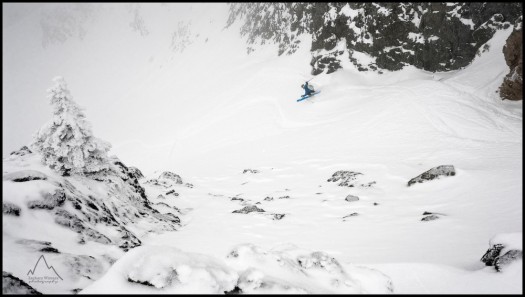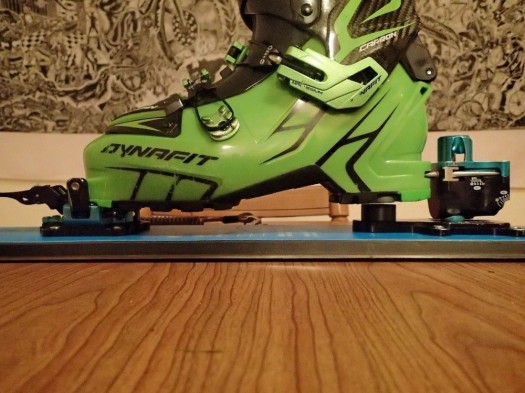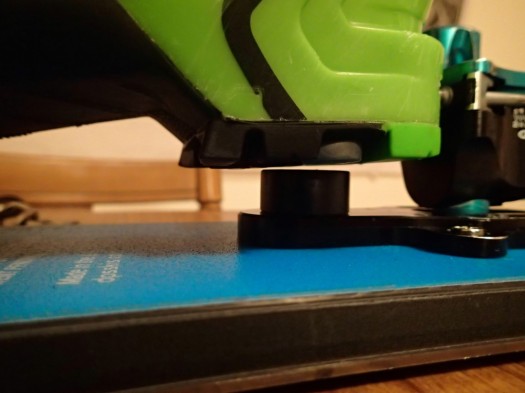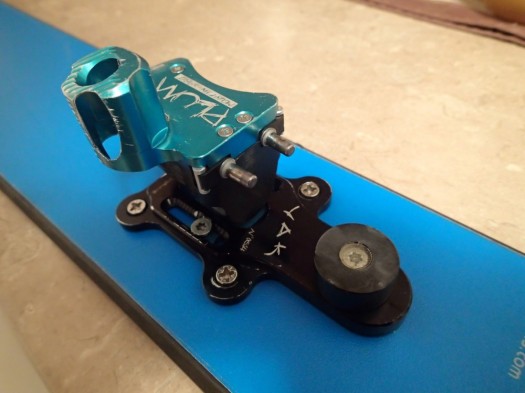Jason Davis
With all the new alpine touring binding options hitting (or about to hit) the market, it almost feels behind the times to review an incarnation of a design that’s been around since the early 90’s. However, the true test of a binding’s performance is how it performs in the long run. I have been using the Plum Yak for over a year now and it deserves a long-term review.
Lou did a nice job covering what makes Yak different from its frère, the Plum Guide and other pintech offerings in his first look here. and gave his initial impressions on how it performs here.
I’ve used Plum Yak on three skis so far, the DPS Lotus 120 Hybrid 178cm, La Sportiva GT 177cm, and the DPS Lotus 120 Pure 189cm. We had drier weather than usual here in the Pacific Northwest earlier this season and I switched the Yaks between the GT’s and the 120 Pures a few times, which are both set up with threaded inserts.
Why use such a wide binding on relatively skinny La Sportiva GT’s? Well, most importantly, these things are expensive and thanks to inserts I can get away with owning just one set of pintech bindings. La Sportiva also assured me that the GT’s binding reinforcement mat is 70 mm wide, wide enough to accommodate the Yak’s 50 mm mount width, but just barely wide enough for inserts. The other factor is that I like the more neutral ramp angle of the Yak and don’t mind the minimal extra weight associated with the built in toe shim and stomp pad.
Plum Yaks work well with inserts due to wider mount holes that accommodate slight variations in insert location. Many folks using inserts with Dynafits have simply widened their holes as necessary to accommodate the tight tolerance needed with inserts.
The stomp pad worked as intended and I’ve had no issue with jumping off pillows and drops, even when the landing was not as soft as expected. I have been able to feel the boot heel bottom out on the stomp pad in some of these situations and it’s a nice reassurance that the heel pins aren’t taking all of the force when landing.
In practice, I haven’t noticed that the stomp pad has interfered with the release value. I’ve had the bindings release in falls when I would expect them to and have never suffered the dreaded tech binding pre-release, even when skiing moguls inbounds (like I said, we had less early-season snow in the PNW than usual). I have locked out the toe at times in no-fall terrain, but the vast majority of my downhill skiing has been in releasable mode with the release values set at 9 for both vertical and horizontal settings. (FWIW, I weigh ~155 lbs.)
One issue I found early on is that snow would freeze to the top of the screw securing the stomp pad and create an unwanted ball of snow under my heel. I put some liquid polyurethane on top of the screw which solved that problem.
The other problem encountered early on was noticing that the toe piece had started to come loose from the shim after my first short tour. I used blue Loctite on all of the screws and they have stayed firmly attached ever since. I emailed Plum to let them know this batch of bindings came from the factory without any thread locker, and they explained that it is written in the user manual to check these screws on a regular basis. I’d rather they just shipped with thread locker and avoid this issue entirely. In the meantime, I’d advise applying some to each of the four toe screws and the length adjustment screws before using the binding.
One of the heel pins has developed a tiny bit of play, which is really only noticeable when standing still or wiggling my leg on the chairlift. It certainly hasn’t affected how they perform on the down and doesn’t bother me. I’ve been using the bindings with leashes, which has worked well and I prefer them over brakes. The leashes that come with the bindings were okay, but I tossed them in favor of a stretchy cable model similar to the B&D leash. However, if you want brakes, Plum is now offering them in 100 mm and 115 mm wide options. They take the place of the toe shim and have forward-facing brake arms. I haven’t seen these in person, but you can find some discussion of the Plum brakes here on WildSnow.
The toe shim is nicely machined out to match the footprint of the toe piece and has the advantage of providing a good pocket of space under the toe springs. This extra space provides enough room to prevent snow from packing underneath the toe springs and while not necessarily designed for this purpose, it is a nice bonus.
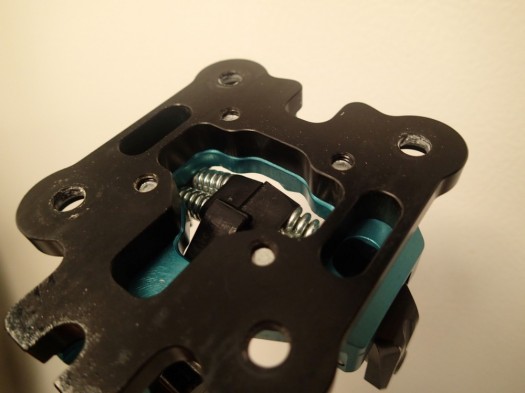
The toe shim allows for space underneath the toepiece, providing enough room to prevent snow from packing under the springs.
One downside to the added stack height of the toe piece with this design is when using non-fixed ski crampons, such as Dynafits, you’ll have to add a shim to the top of them if you want any bite. A cut-in-half piece of ¾” PVC pipe and some gorilla tape did the trick and worked fine on a recent foray up the Boulder Glacier on Mt. Baker. A more elegant solution would be to fashion a spacer out of HDPE, or simply buy B&D crampons that come with boot spacers.
On that recent trip up Mt. Baker, the walk mode lever of one of my bindings seized up and at one point wouldn’t allow me to put one of my skis into walk mode without jabbing the mechanism with the end of a whippet. A bit of veggie oil solved the problem, but it should be noted that the extra metal and tight tolerances used in this design requires a little more diligence with lubrication. Applying some grease a couple times a season should keep them running smoothly.
All in all, these bindings have worked well for me while harvesting corn on the slopes of volcanoes, thwomping pillows in and around the Mt. Baker ski area and following Louie down couloirs. I think they offer a good compromise between a heavy, RV16 beef binding and lighter weight options. In fact I’ve been mostly neglecting my heavier inbounds-oriented setup in favor of the L120’s and Plums on powder days, although that might have something to do with how fun those skis are.
(Guest blogger Jason Davis is a climber, kayaker and skier living in the Pacific North Wet. He works as a sea kayak guide for Discovery Sea Kayaks on San Juan Island, WA during the warmer months and searches for good views, aesthetic lines and soft snow while attempting to work as little as possible during the winter. His other hobbies include coordinating logistics for the WWU Outdoor Center and enjoying vigorous legal debates with polite Canadian Border Guards.)
Beyond our regular guest bloggers who have their own profiles, some of our one-timers end up being categorized under this generic profile. Once they do a few posts, we build a category. In any case, we sure appreciate ALL the WildSnow guest bloggers!

